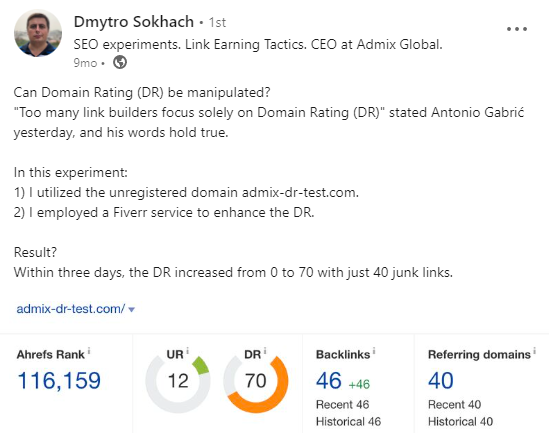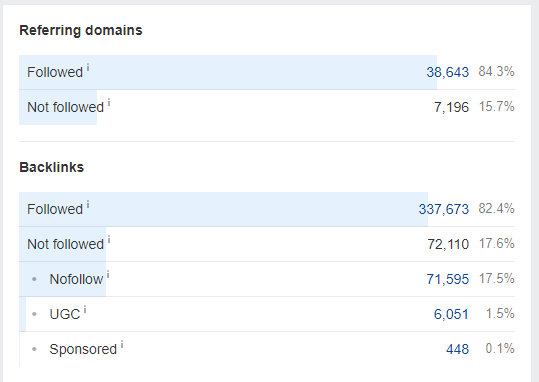A backlink profile is like an investment portfolio. Made up of assets, backlinks, it works for your SERP performance.
And just like with your investment portfolio, you need to manage it carefully to reap the SEO benefits.
That’s why clients turn to our custom link building services to get their backlink profile in shape.
The article explains what makes a strong backlink profile and how to build one.
You will also learn how to analyze your backlink profile using popular SEO tools.
What Is a Backlink Profile?
A backlink profile is the overall pattern and quality of inbound links pointing to your website from other websites.
The key elements that make up a website's backlink profile include:
- Number of backlinks
- Quality of linking sites
- Anchor text distribution
- Link diversity
- Link velocity
- Link positioning
Why is a Strong Backlink Profile Important
Backlinks are critical for SEO performance.
They signal to search engines that your website is valuable and trustworthy. And consequently, influence your rankings. This translates into higher visibility in search results, higher click-through rates, and organic traffic.
It doesn't stop there.
Links from other sites bring referral traffic. It's sometimes more valuable than organic traffic because it brings a prequalified audience to your site: people interested in your subject or product.
This often means higher conversion rates, which is why you're doing SEO in the first place.
More business opportunities come also from increased brand exposure. When popular media outlets and influencers link to your site, they kind of vouch for your product or service. This improves your reputation.
What Makes a Backlink Profile Strong
One of the rules of thumb in SEO is that the more backlinks you have, the stronger your backlink profile.
It isn't as simple as this though. Let's unpack other major factors that affect the strength of your backlink profile.
Organic links
Links acquired organically, or earned, are considered more valuable than built links.
Unlike built links, such links are a true testimony to the value of your content:
You write a good article or create an original infographic, other writers are blown away by the quality, so they decide to link back to it to add value to their sites.
This is the most ethical way to get backlinks. That's how they were meant to be acquired before link-building became a thing.
Backlink quality
For many, backlink quality has become synonymous with the Domain Authority (DA) or Domain Rating (DR). The higher the metric, the more link equity the website passes.
Kind of...
For starters, websites can easily elevate their DA/DR artificially without enhancing the quality of the content, for example, by buying links.

Moreover, the number of outbound links from a domain affects how much link juice they pump. As a result, 2 domains with the same DR can influence your performance to a different extent.
So DR/DA should be just one of the factors to consider when assessing the quality of backlinks. Others include page traffic and the quality of their content. You can often assess the quality of a website just by looking at its design.
❗Remember: The harder it is to get the backlink, the more valuable it is for SEO. Backlinks from Facebook or LinkedIn profiles or forums don't carry as much gravity as editorial links from Forbes or the NY Times.
Backlink relevance
A strong backlink profile consists of relevant backlinks.
Relevant to your niche, product, or your target audience.
The three aren't always the same.
⚠️ For example, Editorial.Link offers a different service from a SaaS company like Surfer, and yet we share the same audience: SEOs, marketing managers, and bloggers. So a link from Surfer would count as relevant for us.
Dofollow and nofollow links
Naturally, you want to have more dofollow backlinks than nofollow ones. They pass link equity to your site, right?
Maybe.
Google has been treating nofollow backlinks as signals when ranking pages since 2019. 54% of SEOs who took part in the uSERP State of Link Building survey believe they impact rankings and page authority, and there have been experiments that confirm it.
When you acquire backlinks organically, there's always a mixture of both types. So having only dofollow backlinks would make your profile look unnatural.
What's a good dofollow to nofollow ratio?
There's no consensus on that. 70:30 or 60:40 are commonly cited in articles but I haven’t found any data to back it up.
Backlink variety
I've already touched upon this one when discussing the other qualities: a good backlink profile consists of various types of links.
A strong backlink profile contains a variety of links from diverse authoritative domains. Diversification also helps ensure your link profile appears natural to search engines.
This includes links from different domains, with a wide spread of DA/DR, different kinds of content (long-form articles, listicles), and different tags (dofollow/nofollow).
Examples of Strong Backlink Profiles
Want to see examples of websites with decent backlink profiles? Here are 3.
Wordtune
Wordtune is an AI writing and reading assistant developed by AI21 Labs.
The Wordtune website has a respectable DR of 75. Currently, it has almost 44K links from nearly 6K domains. Not too shabby!

Wordtune has been acquiring backlinks consistently since it was founded in 2020. The process accelerated towards the end of 2022.
Interestingly, its biggest traffic and DR hikes happened when Wordtune still had relatively few backlinks.

Let's dissect the backlinks a bit further.
Over 73% of links are dofollow.

The majority of backlinks come from websites with DR <30 (around 70%), and about 20% fall into the 50-79 bucket. There are also 336 backlinks from websites with DR90+, including GitHub, Shopify, Zapier, New Your Times, and Stripe.

Backlinko
Backlinko was created by Brian Dean, famous for conducting dozens of link-building experiments and writing hundreds of blog articles.
Curious to see what its link profile looks like?
The website boasts a DR90. Didn't expect any less than this. Almost 46K domains link back to it 410K times.

The link acquisition was more gradual than Wordtune's, and we can see a correlation between backlinks and organic traffic.

Around 82% of the backlinks are dofollowed.

About 55% of them come from low DR sites (<30). Quite a few come from the 50-79 range (over 27%), and there are 6.5k links from DR90+ sites. These include WhatsApp, Microsoft, Adobe, and Vimeo.

Notion
Notion is a productivity, project management, database, and note-taking platform.
The Notion website has an even higher DR than Backlinko - 91. Could this have anything to do with the whopping 51M backlinks from 87K domains?

95% of the backlinks are dofollow.

Where Notion beats the other sites is the DR distribution of the linking sites. Only about 35% of them have a DR of <30. That's less than the 50-79 range, which amounts to over 42%. And even though the DR90+ links constitute only 0.1% of all backlinks, there are 57K of them!

Best Practices for Building a Strong Backlink Profile
Ready to start building a solid backlink profile for your website?
I had a chat with a few seasoned SEOs and marketing managers and asked them for their advice.
Let's have a look at what they had to say!
Use different link-building tactics
As mentioned, backlink diversity is one of the characteristics of a healthy backlink profile. For Viktoria Medvedko, the Founder of Get Mentioned, using a range of link-building tactics is one way to achieve it:
Employ a mix of tactics such as guest blogging, broken link building, and participating in industry forums or communities to diversify your link sources.
What tactics can you use for building links?
- Create linkable assets, like research reports with stats, infographics, free tools, guides, or maps.
- Engage in ABC link exchanges.
- Identify unlinked brand mentions and email website owners to ask for the links.
- Secure niche edits and editorial links.
- Run digital PR campaigns and respond to journalist requests on services like Help B2B Writer, Featured, or Qwoted.
- Take part in interviews and podcasts.
Avoid link farms and link schemes
Black-hat link-building practices can severely damage your backlink profile.
These include:
- Buying backlinks from link farms.
- Using PBNs (Private Blog Networks).
- Generating links using automated programs like GSA Search Engine Ranker.
These tactics are tempting because you can get a ton of backlinks in no time.
However, they dilute your backlink value, can damage your reputation, and in extreme cases, get you a search engine penalty.
Disavow spammy or toxic sites
You never have complete control over your backlink profile. Sometimes spammy and toxic sites link to your site without your authorization. This can bring a search engine penalty on your website and hurt your rankings in search engine results. And harm your reputation by association.
Marc Bishop, the Director at Wytlabs, believes you need to be proactive when dealing with such spammy and toxic sites:
One hallmark of a poor backlink profile is the presence of toxic links. Regular audits are essential to identify and disavow these links to maintain a healthy SEO standing.
How can you identify such sites? Some characteristics include:
- Poor quality content
- Low DR/DA
- Low traffic
- Malware on the website
- High Spam Score (MOZ) or Toxicity Score (Semrush)
Once you identify such sites, use the disavow tool in Google Search Console. This is particularly important if you've already received a penalty or are at risk of getting one.

How often should you analyze my backlink profile?
The frequency depends on your website's activity.
Marie Haynes, a consultant with over 15 years of experience in SEO and an expert in Google algorithms, believes that for most sites, an audit every 6-12 months is plenty.
Unless you have a history of unnatural link-building or have been affected by negative SEO attacks. In this case, monthly audits and disavows may be necessary.

Don't overoptimize anchor text
Anchor text overoptimization is one of the common mistakes that can harm your backlink profile. Debbie Moran, the Marketing Manager at RecurPost, learned it the hard way:
An unnatural distribution of anchor text can land you in hot water with search engines. At RecurPost, we previously focused more on exact-match anchor texts, thinking it would improve our rankings for specific keywords. However, eventually, we realized that Google’s algorithm detects this pattern and could penalize for over-optimization.
So what's the alternative?
Viktoria Medvedko suggests using variations of keywords, branded terms, and natural language for your anchor texts not to appear over-optimized.
If you want to see a good example of what we mean, check out the 2 passages:

Work with a reputable link-building agency
Wesley Cable, an SEO Specialist at Creativity Next Solutions, believes that the best way to ensure a healthy backlink profile is to work with a reputable link-building agency:
I am not talking about hiring someone on Fiverr to get you a bunch of spam links, I am talking about finding a reputable company. There are companies out there that can get you the links you need from sites in your niche that are high-quality and have high traffic.
A good link-building agency, like Editorial.Link, doesn't just focus on adding backlinks to your profile.
They start with an in-depth analysis of your profile to identify its strengths and weaknesses and use the insights to design a bespoke SEO strategy that helps you achieve your goals.
How to Analyze Backlink Profile
To perform effective backlink profile analysis, you need a backlink checker, like Ahrefs, SEMrush, MOZ Link Checker, or Ubersuggest.
Here's how to do a quick audit in Ahrefs, my go-to SEO suite:
1) In Site Explorer, check the number of Backlinks and Referring domains.

2) In the Backlink profile tab, analyze the link acquisition pattern over time. Look for unnatural spikes.

3) Have a quick look at the dofollow/nofollow ratio and link distribution by DR.

4) Analyze TDL distribution for unusual patterns. For example, if there are lots of backlinks from locations with small populations unlikely to generate large traffic volume.
5) Scan the anchor texts for irrelevant terms. For more details, head to the Anchors report and filter it by spammy terms, like 'online casino' or 'weight loss pill'.

6) Head to the Backlinks report, and order the referring domains by DR from low to high. Scan the results for irrelevant or dodgy-looking sites.

Final Words
A healthy and diverse backlink profile is a testament to the quality of your content and your SEO efforts. It signals to search engines and users alike that your site is trustworthy and relevant.
Hopefully, following the best practices outlined in this guide and regularly auditing your backlink profile will help you build a robust backlink strategy that drives organic traffic, enhances your online reputation, and supports your overall SEO objectives.
Remember though that a strong backlink profile isn’t built overnight but through consistent, ethical link-building efforts and careful management.
Not sure you want to do this in-house?
Get in touch with the Editorial.Link and see how we can help you build a robust backlink profile.






